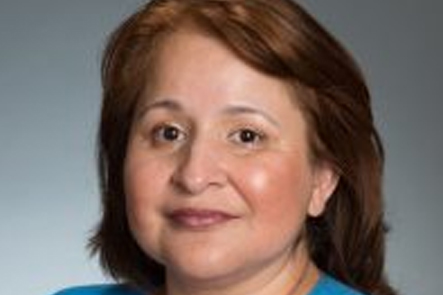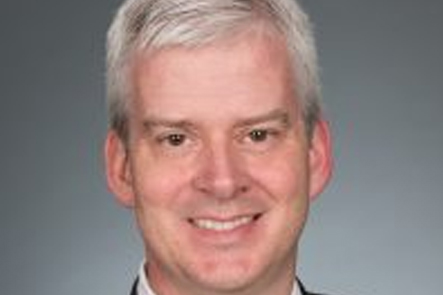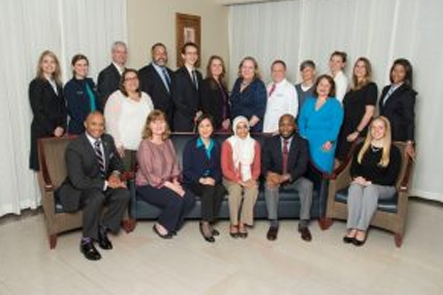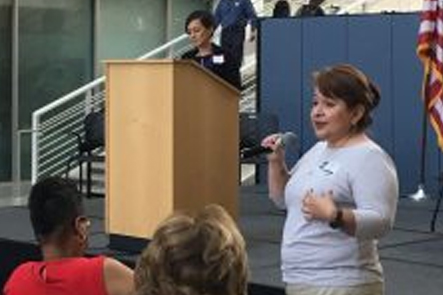Find care now
If you are experiencing a medical emergency, please call 911 or seek care at an emergency room.
We’ve felt strongly from the outset that the PFACQS would not simply be another committee obligation for our members. We had a mission and a shared aspiration to make a real difference. Soon each of us became invested in ensuring that the goals we established would be achieved — and our energies well spent. We have tackled a host of issues — from the simple to complex — and we are proud of our accomplishments.
You will read more about five important initiatives we have undertaken in the last two years in the pages that follow in this first report to the community. These projects grew out of the council membership’s brainstorming and free exchange of ideas. We talked about what works and doesn’t work for patients and caregivers — examined the problems, and set about to determine effective solutions. Then we got to work focusing on the critical areas of communications, transparency, self-advocacy, and education.
We are making inroads to inform hospital associates, medical students, patients, and their families about the value of shared decision making in health care to preventing medical errors and improving patient outcomes. And we are helping to design infrastructure — and interactions — that ensure patient safety, privacy, and personal autonomy.
There is much more to be done. Still, we have seen that we can be an effective platform for improving health care. The council has been a positive experience for all of us — and we are determined to continue to make a real impact on improving the quality of the patient experience at MedStar Georgetown for many years to come.


Ideas into action

A dramatic — and positive — shift in health care is fostering quality, safety and accountability. Silos are breaking down and communication is improving, the result of a growing partnership between patients, families, and care teams. At MedStar Georgetown University Hospital, and across the MedStar Health system, Patient and Family Advisory Councils for Safety and Quality (PFACQS) have become the driver for effective change to reduce medical error and increase quality of care.
In 2013 a small team of MedStar Georgetown associates gathered together to jump start the process and create a charter for the council. The charter puts structure to the belief that the key to better medicine is practicing honest communication between providers and patients, full discloser about the risks and benefits of treatment — and promoting the value of shared-decision making.
Building the council has been a three-year project that included a careful assessment of the care environment and a year-long, vetting of applicants from among a number of interested MedStar Georgetown associates and members of the hospital’s community of patients and families.
The result of this slow and deliberate interviewing process is an energetic group of diverse individuals who have made a personal commitment to the council’s mission. “Once in a lifetime you see a group of people come together with such success,” says Lisa Boyle, MD, vice president for medical affairs and chief medical officer. “It’s been an honor to watch them work.”
“The landscape of health care has changed,” says Eileen Ferrell, MSN, BSN, chief nursing officer. “We now know that encouraging patients and families to be active participants in their health care is critical to improving satisfaction and outcomes.”
By fall 2014, the council had met for the first time, enthusiastically debated topics of interests and soon established a set of ambitious goals:
-
Provide ongoing feedback to MedStar Georgetown University Hospital that evaluates and seeks to improve patient safety, quality of care, or patient service issues.
-
Assist MedStar Georgetown University Hospital to continually improve the quality, safety, and efficiency of services it offers the patients and families who seek care at MedStar Georgetown University Hospital.
-
Strengthen communication and collaboration among patients, families, and other non-professional caregivers, and MedStar Georgetown University Hospital professional staff and associates.
-
Promote information sharing between MedStar Georgetown University Hospital and the patients, families, and community it serves.
-
Aid in establishing MedStar Georgetown University Hospital organizational priorities in response to patient, family, and community needs.
The goals are the broad strokes of projects the council has undertaken to develop a “high reliability organization,” says Boyle. “In health care, there are many opportunities for missteps but also for making real and positive change. The MedStar Georgetown PFACQS has proven that a group of committed, like-minded people can create an environment that fosters free and open dialogue, trust and a culture of excellence.”
Improving patient communication

Plain language. To the point. Easy to read. And representative of the diverse patient-base the hospital serves.
When the PFACQS discussed improving communications with patients and families two publications topped the list of projects to tackle: The Patient Handbook and Preparing for Surgery.
“The 32-page handbook is given to each inpatient when they arrive at the hospital,” explains Amber Ostrup, community member and part of the small working group that volunteered to review the publication. “We knew instantly that it was too long, too complicated and cumbersome for patients who are already overwhelmed by hospitalization.”
There was important information that people need in the booklet, and much that was redundant. Critical passages were lost among less important information. “We knew we needed to streamline the booklet, make it welcoming, and hone in on what patients really need to improve their experience,” says Ostrup.
Fine tuning tools
“Medicine is complex and a hospital can be a frightening and intimidating place for patients,” adds Sandra Kaus, PFACQS co-chair and former patient. “The council is working in many ways to demystify hospitalization, and the tools we use to communicate with patients is an important place to begin the process,” she explains. “The council is a platform that enables us to be the voice of the patient and improve their experience from the moment they step through our doors.”
Revamping the Patient Handbook began with a brainstorming session in which council members voiced concerns and questions — a plethora of suggestions that was then handed over to the working group.
Read pens in hand, “we went through every word on every page,” says Kaus. “We took it apart, reordered the sections, removed repetition of information and simplified the language. We clarified important phone numbers, added TV channel listings, and offered up ways to improve the map so it could really help guide people through the buildings. ”
“We added diversity in the photos of patients and added tabs so that patients and families could easily find what they needed,” adds Ostrup. “Sandra and I were like ‘right side, left side’ of a single brain!”
Devil in the details
When they completed the overhaul, the booklet went back to the full council for review, and on to Marketing for publication. Then the group tackled the Preparing for Surgery booklet with the same attention to detail.
These projects are step one in a broad range of issues related to communication that the PFACQS hopes to tackle. The spoken word — and silences — between patients, families, and the care team are even more powerful. “We believe our job is to help build bridges so that we can all recognize and respect the differences between us, understand the real impact of every interaction we have with one another — and work to improve the quality of the patient experience,” Kaus adds.
Designing the future

Hundreds of hours of grueling cancer treatment. Months of hospitalization for a son. The heart-wrenching loss of a parent. Three individuals. Three families who represent thousands of personal and — sometimes painful — hospital experiences. As PFACQS members, Amber Ostrup, Sandra Kaus and Steven Coffee are hoping to give voice to their collective concerns and perspectives.
They and the other council members had a unique opportunity to share their hospital journeys and play a critical role in the design of a new patient care tower slated to open in 2020. Representatives of the architectural firm visited the council and listened to member’s personal stories — then put them through a “mapping experience” exercise that proved eye opening for everyone.
Mapping the emergency experience
“The architects wanted to ensure that they had patient and family feedback during the design process,” says Nicole Duncan, assistant vice president of advocacy and international services. ”The pavilion will house the ED, ICU, and surgery — areas that can pose real issues for patients and caregivers.”
During the mapping experience, the council members were divided into small groups and given two scenarios to ponder: Envision moment by moment what patients experience when they enter the emergency department either as a walk-in or by ambulance.
“What we discovered was the large effect small things have on the quality of the patient experience,” says Kaus. “The distance from the garage to the ED, the lack of patient privacy, and access to food during a long wait for care — even not having a phone charger handy — create stress during an already stressful time,” she says. “The exercise allowed us to say ‘what if,’ and ‘what’s best for customers.’ There were some real light bulb moments.”
“It’s a chance to identify some of the gaps in service that the hospital may not know it has,” says Coffee, whose son was just two months old when he had a liver transplant at MedStar Georgetown. “They are saying, ‘we want to hear your story, we want to see things as you see them.’ And they are asking ‘what would be your ideal hospital experience?’ We also realize that the clinicians have their own stories too, and that we are all part of the health care team.”
The group talked about everything from confusing discharge orders and long transfers between the ED and patient units — to dark and scary garages. “We heard from many perspectives and no ideas were discounted,” says Ostrup.
Respect and value
“The council is a diverse group — finance people, lawyers, clinicians, parents, patients — and this spectrum of people is very valuable in everything we do,” says Coffee. “The whole experience is near and dear to me. I speak for my son, but also for increasing an understanding of what makes quality care. It’s the human side of medicine that recognizes in health care, ‘you respect and value my opinion as much as I value your advice.’”
“The mapping experience is just the beginning of a process the architects are implementing before the brick and mortar of the new patient care building are set,” explains Duncan. “They will continue to solicit the council’s input, and they are not only embedding their ideas into the design, but we are also incorporating them now into existing space.”
Building better, safer medical devices

Technology has transformed medicine. Yet devices can also separate patients from caregivers — and health care from the compassion in caring. And with each new lifesaving tool the opportunity for error is compounded, as well. It’s a conundrum the U.S. Food and Drug Administration (FDA) recognizes and is hoping to resolve with the help of MedStar Georgetown PFACQS.
The FDA’s Medical Product Safety Network (MedSun) is an adverse event reporting program working collaboratively with the clinical community to identify, understand, and solve problems with the use of medical devices. The program was initiated in 2002 as a partnership between the FDA and clinicians and clinical institutions nationwide to try to prevent device-driven medical errors before they occur.
MedStar Georgetown model
“More recently, MedSun has wanted to increase patient engagement in their process and they reached out to us for our input,” explains Yasmin Yusuf, MHA, Center for Patient Safety.
Janet Camp, a representative of MedSun, was invited to a PFACQS meeting, introduced council members to MedSun’s work, heard first-hand the stories of community members — and watched the group in action.
“She was very impressed and invited us to make a presentation at a MedSun meeting to talk about the development of our PFACQS and our accomplishments,” recalls Mary Herold, BSN, RN, risk management. “She also asked Sandra Kaus to tell the group her personal story.”
Heart and soul in care
Kaus’s own late diagnosis of breast cancer put her on the road as a patient advocate and “change agent.” As the community co-chair of PFACQS, she is intent on making hospital care a “hopeful experience” for patients, families and the health care team. “I want to put the heart and soul into this effort.”
Kaus spoke with honesty and humor to an enraptured and hushed audience at the FDA. “I talked about every aspect of my diagnosis and treatment — the biopsy, the awkward breast MRIs that leave you dangling upside down in the air for more than 35 minutes,” she says. “I could literally hear some in the audience groan,” Kaus says laughing.
The presentation — and Kaus’s persuasive storytelling—touched the participants. They understood how significant the patient perspective is to their efforts to improve care — and are now interested in creating their own patient engagement group.
“Mary and I were invited to come back to speak to a group and take them through our process, to tell them how we formed a PFACQS, what we have accomplished and where we are headed,” says Yusuf. “They are using our council as the model — we’re teaching them how to engage patients in their efforts, how to hear their voices — and how to empower and educate patients, families, and health care professionals from across the country.”
Training health care professionals-in-training
In the massive litany of facts that engulf medical students during four years of training, creating a culture of safety in patient care can get lost. But increasingly the value of open and honest patient-physician communication to reducing medical error is establishing a strong foothold in education. At MedStar Georgetown, PFACQS members and fourth-year medical students Sam McAleese and Katherine Koniares are helping to bring this message to the nearly 1,000 health care professionals-in-training at Georgetown University School of Medicine.
Raising interest, expectations
“My role in the council is to bring the student perspective to our mission — and to introduce our work to fellow students,” McAleese says. “Our short-term goal is to raise awareness–having Katherine and me present at council events is helping to peak student interest.”
McAlvee’s own interest peaked when he embarked on a MedStar Heath system-wide research project the summer after his freshman year. “I spent 10-weeks collecting data to examine the challenge sepsis poses in MedStar Health hospitals. It was an assessment to determine how we respond to the hospital-based infection — and in what ways we can standardize and improve protocols across-the-board,” he explains. The experience convinced McAleese of the value of team-based care and open communication between patients, providers, residents, and students in the process.
“From the educational point of view, I think we do it well here,” he says. “We have classes that focus on patient and physician communication with panels and interaction with hospital patients, and an immersion day for students that focuses on how patient safety issues can occur when there is a breakdown in communication. Still we know we can do more — and as a council member that’s my hope.”
Reinforcing safety, teamwork
As Koniares begins her own immersion into the world of labor and delivery during her fourth year clerkship she is mindful of the lessons she has learned during the last year. “Everything I’ve been thinking about and studying will be put into practice every day,” she says.
The issues of patient safety became very real to Koniares as she was completing her medical school project — a research study to “assess the level of teamwork and the perceived culture of patient safety as viewed by health care personnel in different units of MedStar Georgetown.”
Koniares’ results reinforced her gut feelings about the hospital: In all units, a majority of associates feel they support one another, work together as a team to get the job done and feel free to voice concerns if they suspect something is wrong.
This past summer, Koniares was invited to attend the MedStar Academy for Emerging Leaders in Patient Safety for medical and nursing students in Colorado — an international initiative founded by David Mayer, MD.
“It was four days of rich discussion about communication, safety and quality in health care,” Koniares explains. “I’m now part of a growing alumni of the camp who are working to spread the idea of safety in health care,” she adds. “I think that it is important to begin this training early on and keep re-enforcing the notion throughout our careers as physicians,” Koniares says.














